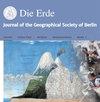A novel approach in monitoring land-cover change in the tropics: oil palm cultivation in the Niger Delta, Nigeria
IF 0.6
4区 地球科学
Q3 GEOGRAPHY
引用次数: 25
Abstract
The increasing demand for palm oil and bioenergy has promoted the expansion of tropical farmland covered with oil palms (Elaeis guineensis), resulting in increased competition with food production as well as environmental degradation. Moreover, oil palm cultivation may have increased greenhouse gas (GHG) emissions through deforestation. The overall impact estimation of oil palm related land-use change requires spatiotemporal land-use maps. So far, the Roundtable on Sustainable Palm Oil (RSPO) has not established guidelines on how to measure and evaluate oil palm related land-cover change. While remote sensing methods are suitable in general, the use of Landsat images in the tropics for the monitoring and modeling of land-cover changes has been restricted due to the influence of cloud cover. This study presents a novel approach for mapping tropical land-cover change using the Google Earth Engine (GEE) cloud-based platform and the System for Automated Geoscientific Analysis (SAGA) GIS. Spatiotemporal land-use and land-cover changes in relation to oil palm cultivation are assessed using a median pixel composite mosaic of Landsat 5, 7 and 8 image scenes for the time periods 1999-2005 and 2009-2015. The proposed approach yields an overall accuracy and kappa coefficient of 70.33 % and 0.62 for the first image composite period, and 84.5 % and 0.80 for the second image composite period respectively监测热带地区土地覆盖变化的新方法:尼日利亚尼日尔三角洲的油棕种植
对棕榈油和生物能源日益增长的需求促进了热带油棕(Elaeis guineensis)覆盖农田的扩大,导致粮食生产竞争加剧以及环境退化。此外,油棕种植可能通过砍伐森林而增加温室气体排放。油棕相关土地利用变化的总体影响评估需要时空土地利用图。到目前为止,可持续棕榈油圆桌会议(RSPO)还没有建立关于如何测量和评估与油棕有关的土地覆盖变化的指导方针。虽然遥感方法一般来说是合适的,但由于云层的影响,在热带地区利用陆地卫星图像监测和模拟土地覆盖变化受到限制。本研究提出了一种利用谷歌地球引擎(GEE)云平台和自动化地球科学分析系统(SAGA) GIS绘制热带土地覆盖变化的新方法。利用1999-2005年和2009-2015年期间Landsat 5、7和8图像场景的中位数像元复合马赛克,评估了与油棕种植相关的土地利用和土地覆盖时空变化。该方法的综合精度为70.33%,第一合成周期的kappa系数为0.62,第二合成周期的kappa系数为84.5%,0.80
本文章由计算机程序翻译,如有差异,请以英文原文为准。
求助全文
约1分钟内获得全文
求助全文
来源期刊

Erde
GEOGRAPHY, PHYSICAL-GEOSCIENCES, MULTIDISCIPLINARY
CiteScore
2.90
自引率
6.20%
发文量
0
审稿时长
>12 weeks
期刊介绍:
DIE ERDE is a publication of the Geographical Society of Berlin
DIE ERDE is a scientific journal in Geography, with four issues per year with about 100 pages each. It covers all aspects of geographical research, focusing on both earth system studies and regional contributions.
DIE ERDE invites contributions from any subfield of both Physical and Human Geography as well as from neighbouring disciplines.
 求助内容:
求助内容: 应助结果提醒方式:
应助结果提醒方式:


